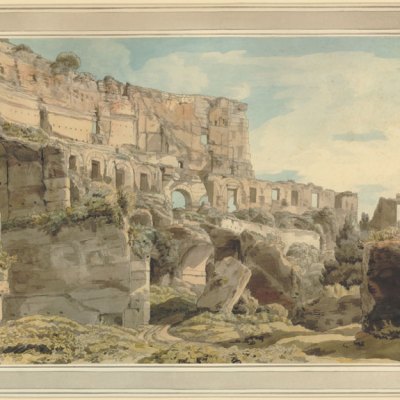The British Museum is currently showing an exceptional display of landscape watercolours selected almost entirely from its own collection. The quality is consistently high across the 125 works presented, but remarkably more than half of these drawings have never previously been exhibited or published. How can such a fine array of British watercolours have been kept hidden for so long?
The answer is that the works displayed are not products of the ‘great age’ of British watercolour – the era of artists such as J.M.W. Turner, John Constable, Thomas Girtin and John Sell Cotman – but were made after, in the late Victorian period or the first half of the 20th century. The prevailing view has been that the death of Turner in 1851 marked something of a watershed, after which the quality of watercolour painting in Britain went into sharp decline. In the decades that followed, landscapes in this medium became meticulous and over-laboured – technically accomplished, certainly, but lacking the expressiveness or clarity of design that was to be found in the best examples from the earlier period. Watercolour was deemed inferior to oil painting, associated with amateurs and female painters, a pastime rather than a profession. Consequently, by the beginning of the 20th century few in the art establishment regarded watercolour as medium for serious artists, or with any relevance to the avant-garde.
Or so the story goes. The aim of the British Museum’s current exhibition – ‘Places of the Mind: British Watercolour Landscapes 1850–1950’ (until 27 August) – is to challenge these assumptions by bringing long-overlooked drawings into public view. What we discover is that watercolour painting was alive and well in the century after Turner, and was used in new and inventive ways by British artists to explore their personal visions of landscape. Tastes were constantly evolving and the aesthetic values that shaped watercolour painting were at times intensely contested – around the status attached to watercolour sketches compared with finished drawings, for example.
The exhibition features works by dozens of different artists, most represented by just one or two watercolours. Few of the Victorians are household names now, though many such as William Simpson and Myles Birket Foster were highly regarded in their own day. Some of the later artists are better known, but not necessarily for their work in watercolour: Henry Moore, Graham Sutherland, and John Singer Sargent, for example (the latter’s watercolours will be the subject of an exhibition at Dulwich Picture Gallery in the summer). The watercolours displayed at the British Museum are extremely diverse: there are works that are painstakingly executed, as highly finished as any oil painting, such as John William North’s The Old Bowling Green, Halsway Court, Somerset (1865); and at the other extreme, Ambrose McEvoy’s River Landscape (c. 1910s, a freely handled sketch painted in rapid washes of colour.
River Landscape (c. 1910s), Ambrose McEvoy. © The Trustees of the British Museum

The exhibition borrows its title from a 1949 collection of essays by the poet and critic Geoffrey Grigson, which encapsulates the idea that landscape drawing is more than just description, but has an imaginative or spiritual dimension, about conveying the essence of the place. The show explores the contemplative aspects of watercolour practice, as a deep engagement with nature and a closely studied search after the truth. For many Victorian artists their reverence for nature was founded on their religious convictions, beliefs that are easily overlooked by art historians today. In other cases, artists were striving to recover mystic or primeval qualities hidden within the native landscape. A specifically English vision of the countryside emerges, one that is imagined as an ‘other Eden’, a separate reality from the modern, urban, industrial world. After 1914, attitudes to landscape were reshaped by the trauma of war.
View on the River Teme, Ludlow, Shropshire (1872–73), George Price Boyce. © The Trustees of the British Museum

George Price Boyce’s watercolours were praised by his contemporaries for being ‘solemn and severe in their Englishness and simple truth’. In his View on the River Teme, Ludlow, Shropshire (1872–73) he described a river landscape under an overcast sky. Avoiding the effects of strong sunlight and shadow, and working within a narrow tonal range of greens, Boyce conveyed a mood of dispassionate stillness. Nearly 40 years later, in The Wanderer (1911), Paul Nash used a similarly narrow range of hues, in this case muted greys and blues, to create a crepuscular, dreamlike image of trees and a cornfield. Nash described some of his works as ‘a curious record of a psychological state of mind’.
The Wanderer also known as Path through Trees (1911), Paul Nash. © The Trustees of the British Museum

The exhibition is a valuable revision of the way we understand the development of British watercolours. But the British Museum is not a neutral observer of the processes of neglect and rediscovery described here. Its department of prints and drawings holds the national collection of works on paper, including over 30,000 British drawings and watercolours. Its own curators were (and are) influential in shaping public appreciation of British watercolour, through the department’s activity in acquiring, evaluating, and presenting works in the collection. To its credit, the current exhibition explicitly acknowledges the museum’s role in this respect, questioning the ways in which tastes and perceptions are formed. In doing so, this expertly curated show recognises this isn’t the end of the story, but one further stage in the ongoing history of this rich collection.
‘Places of the Mind: British Watercolour Landscapes 1850–1950’ is at the British Museum until 27 August 2017.



